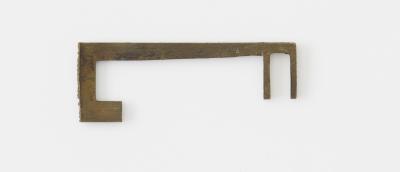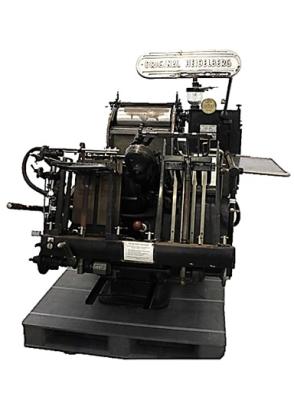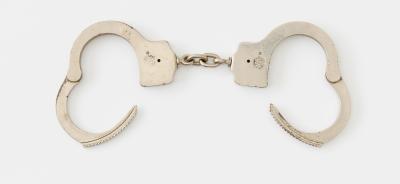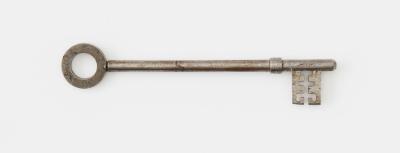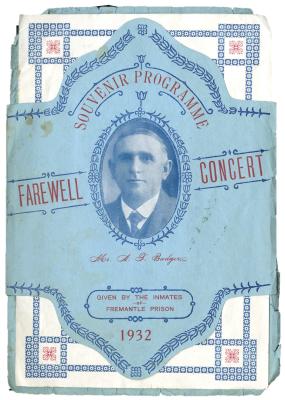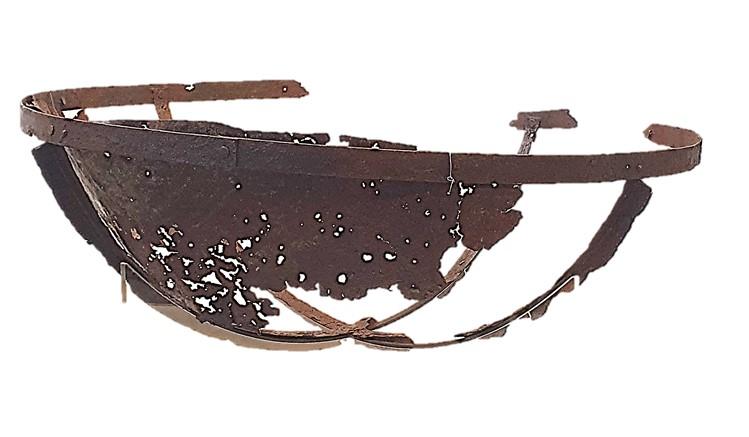VESSEL USED IN THE TUNNELS
c. 1880 - 1889Large, round, semi-spherical, heavily corroded vessel. A large, circular band of iron, creating an upper rim frame for the top of the vessel. Two supporting, semi-spherical bands of iron are attached to the sides of the upper rim, crossing over at the base of the vessel, creating an open half circle. One section of the original galvanized metal sheeting that was attached to the outside of the frame is still in place. The sheeting is heavily corroded and damaged and is affixed to the iron frame with copper rivets.
Found in the western end of tunnel N3 at the south of the Fremantle Prison tunnels. Possibly made in the Fremantle Prison Metal Shop. Likely used in the construction of the tunnels in the 1880s. First (attributed) mention of these vessels is in a plan of the tunnels titled 'Shafts & Drives' dated 7 July 1914 (2021.180.6). Three crosses labelled 'OLD GEAR' mark a location at the western end of tunnel section N3 where these vessels were found. This section of the tunnels is noted to be 'DRY'. A 1898 tablet is also mentioned on the plan.
On February 3, 2014, these vessels were carefully extracted from the Prison Tunnels and conserved. Made of an iron frame lined with sheets of steel. Rivets are still visible but no other construction details or marks were revealed by the conservation process.
Details
Details
Below the foundations of Fremantle Prison is a natural aquifer, which was critical for the supply of fresh water to the new colonial town of Fremantle. Inmates at Fremantle Prison were forced to excavate through the natural limestone by hand, to create the more than one kilometre of tunnels required to access this resource.
Between 1852 and 1856 six wells, each about 20 metres deep, were sunk into the Prison grounds, to tap into the porous limestone aquifer beneath the caprock. For more than 30 years the water was raised by hand pumps operated by the convicts. The work was physically demanding, with at least one prisoner reported to have died whilst pumping water, and several others sustaining serious injury as a result of this gruelling work.
The Prison’s water was first used outside the walls of the Establishment in 1874, to supply ships at Fremantle’s newly constructed Long Jetty, through pipes laid along High Street. As more and more ships began calling into Fremantle Harbour to take advantage of this service, a below ground reservoir was excavated from the limestone of the Prison’s South Knoll, to provide 200,000 litres of storage capacity. In 1882 the Colonial Secretary suggested that Fremantle Council begin using water from the Prison, and soon the Prison’s water was also supplying thousands of free settlers in Fremantle.
In 1888 the first beam balance pump operated by a steam engine was installed, and the prisoners were finally released from the back breaking work of manual pumping. The water tunnel complex under the Prison was completed in 1894, covering about 1,000 metres, of which 750 metres are flooded to about half the height of the walls.
After the completion of the tunnels, a project was begun to sink three new wells, connecting them with shafts, drives and tunnels underground, in the north east area of the Prison. Water from this complex was pumped into a new storage facility at the Prison, the East Reservoir, built in two stages in 1890 and 1897. Excavated out of solid rock, it took 8,000 days of prisoner labour, more than 200,000 bricks and 740 barrels of cement to build.
However, after all the effort and hard work, an analysis of the water in 1899 showed that rising levels of organic salts in the water made it unsuitable for domestic use. By now new sources of fresh water had been found, and by 1910 the Prison itself was connected to Fremantle’s metropolitan water supply scheme. Its own natural water supplies were no longer the lifeblood of the town, and were now only used to irrigate the Prison’s gardens and lawns.
When the tunnels under Fremantle Prison where prepared for public tours in 2004, these two coracles where discovered semi-submerged in silt. In the absence of written records, it is presumed that these coracles were used during the construction of the tunnels in the 1880s, to carry tools and supplies in the submerged parts of the tunnels. They have similarities in shape and construction with traditional watercraft called ‘coracles’ and made of wood and animal hide, used by fishermen in Wales and other parts of the United Kingdom. These examples are made using an iron frame, lined with sheets of steel. Rivets are still visible but no other construction details or marks were revealed by the conservation process.
These vessels are of high historic significance, with their strong provenance to the construction of the tunnels system at Fremantle Prison. They are rare examples of this this type of vessel, representative of small water craft used in such confined situations. They have strong interpretive potential, signifying the local manufacture of essential equipment within the Prison’s setting.

